Class 10 Maths Chapter 7 Case Based Questions - Coordinate Geometry
Study Case - 1
The class X students of a school in Rajinder Nagar have been allotted a rectangular plot of land for their gardening activity. Sapling of Mango are planted on the boundary at the distance of 1 m from each other.
There is a triangular grassy lawn in the plot as shown in figure.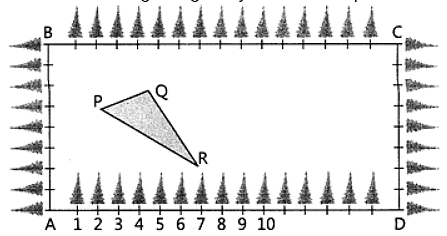
Based on the above figure, answer the following questions:
Q1: Taking A as origin, the coordinates of vertices of the triangle are:
(a) (1, 5), (4, 6), (7, 2)
(b) (2, 4), (3, 5), (6, 3)
(c) (1, 4), (4, 5), (7, 3)
(d) None of these
Ans: (a)
Explanation: Taking A as origin, we will take AD as X-axis and AB as Y-axis.
So, coordinates of point P, Q and R are (1, 5), (4, 6)and (7, 2)respectively.
So, option [a] is correct.
Q2: The perimeter of ΔPQR is:
(a) (10 + √5 + 3√5) units
(b) (√10 + √8√5) units
(c) (10 + 3√5) units
(d) (10 + 5√3) units
Ans: (a)
Explanation: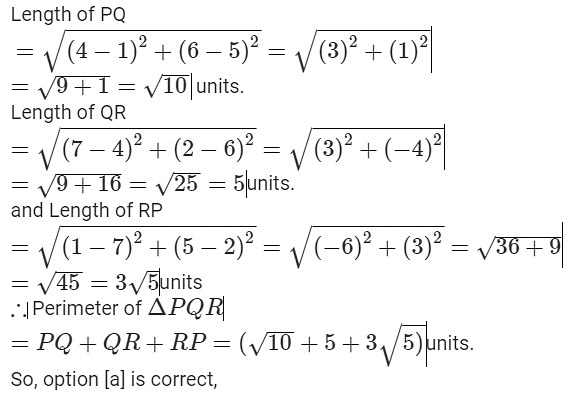
Q3: The coordinates of the point M on PR such that PM : MR = 2 : 1, is:
(a) (4, 3)
(b) (5, 3)
(c) (5, 4)
(d) (2, 3)
Ans: (b)
Explanation: Given, M divides PR in the ratio 2 : 1
∴ Coordinates of
Q4: What will be the coordinates of the vertices of ΔPQR if C is the origin?
(a) (14, 3), (11, 2), (8, 6)
(b) (15, 4), (12, 3), (9, 7)
(c) (14, 2), (11, 1), (8, 5)
(d) (15, 3), (12, 2), (9, 6)
Ans: (d)
Explanation: When C is taken as origin, we will take CB as X-axis and CD as Y-axis.
Then, coordinates of points, P, Q and R are (15, 3), (12, 2)and (9, 6) respectively.
Q5: What are the coordinates of P if D is taken as the origin?
(a) (−15, 5)
(b) (15, 5)
(c) (15, 7)
(d) (15, 3)
Ans: (a)
Explanation: When D is taken as origin, we will take DA as negative X-axis and DC as positive Y-axis.
Then coordinates of point P is (−15, 5).
Case Study - 2
All of the persons know that smoking is injurious to health. So, college students decided to make a campaign. To raise social awareness about hazards of smoking, school decided to start "NO SMOKING" campaign. Some students are asked to prepare campaign banners in the shape of triangle as shown in the figure: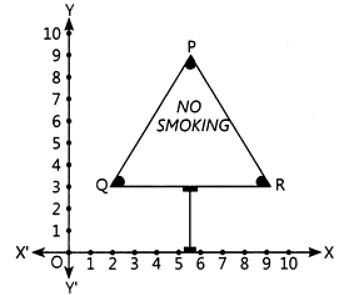
Based on the above information, give the answer of the following questions:
Q1: The coordinates of the mid-point of Q and R are:
(a) (5, 3)
(b) (6, 3)
(c) (11/2, 3)
(d) (7, 3)
Ans: (c)
Explanation: The coordinates of the vertices Q and R are (2, 3) and (9, 3)respectively.
∴ Mid-point of Q and
Q2: The distance between P and R is:
(a) 3 units
(b) 3.5units
(c) 3√5 units
(d) 5√5 units
Ans: (c)
Explanation: The coordinates of the vertices P and R are (6, 9)and (9, 3)respectively.
Q3: The area of the triangle PQR is:
(a) 21 sq. units
(b) 35 sq. units
(c) 42 sq, units
(d) 45 sq, units
Ans: (a)
Explanation: The coordinates of the vertices P, Q and R(6, 9), (2, 3)and (9, 3) respectively.
Now, base of the
and height of the ΔPQR = Perpendicular distance from the vertex P to the base QR = (9 − 3) = 6 units.
∴ Area of
Q4: The point on X-axis, which is equidistant from points Q and R is:
(a) (112, 0)
(b) (5, 0)
(c) (6, 0)
(d) (5, 3)
Ans: (a)
Explanation: 
Q5: The centroid of the triangle PQR is:
(a) (5, 5)
(b) (6, 5)
(c) (17/3, 4)
(d) (17/3, 5)
Ans: d
Explanation: ∴ Centroid of the
Study Case - 3
SLV-3 was successfully launched on July 18, 1980 from Sriharikota Range (SHAR), when Rohini Satellite, RS-1, was placed in orbit, thereby making India the sixth member of an exclusive club of space-faring nations.
SLV-3 employed an open loop guidance (with stored pitch programme) to steer the vehicle in flight along a predetermined trajectory. The successful culmination of the SLV-3 project showed the way to advanced launch vehicle projects such as the Augmented Satellite Launch Vehicle (ASLV), Polar Satellite Launch Vehicle (PSLV) and
Geosynchronous Satellite Launch Vehicle (GSLV) Students of Class-Xth made a mathematical model of a rocket as shown in the figure below: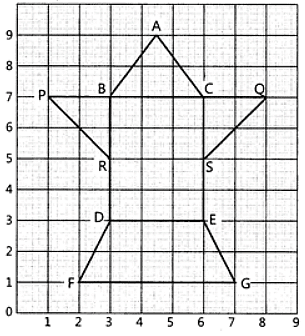
Based on the above information give the answer of the following questions:
Q1: The coordinates of the point A are:
(a) (4,9)
(b) (5,9)
(c) (92,9)
(d) (4,8)
Ans: (c)
Explanation: As the distance of point A is 9/2 units from the Y-axis and 9 units from the X-axis, its coordinates are
x = 9/2, y = 9 or (9/2, 9)
Q2: The type of triangle ABC is:
(a) equilateral triangle
(b) isosceles triangle
(c) scalene triangle
(d) right triangle
Ans: (b)
Explanation: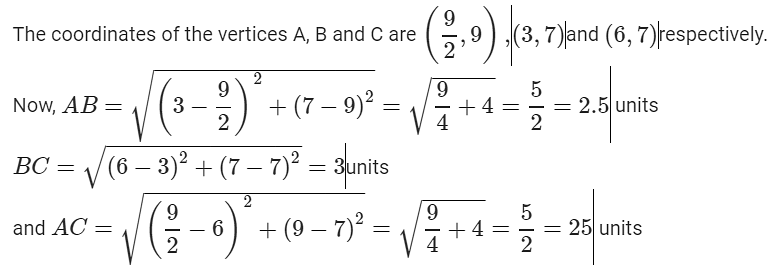
As, two sides AB and AC are equal, it is an isosceles triangle.
Moreover, BC2 ≠ AB2 + AC2
∴ ABC is not a right triangle.
Q3: The area of triangle RBP is:
(a) 2 sq. units
(b) 4 sq. units
(c) 3/2sq. units
(d) 5 sq. units
Ans: (a)
Explanation: The coordinates of the vertices R, Band Pare (3, 5), (3, 7)and (1, 7) respectively. Now,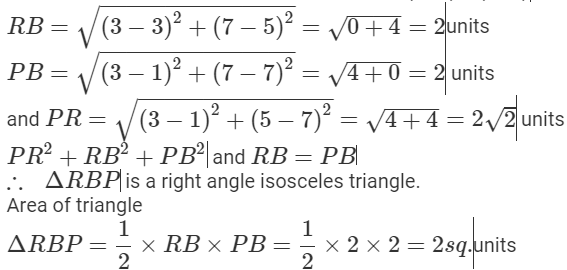
Q4: The area of rectangle BCED is:
(a) 8 sq. units
(b) 10 sq. units
(c) 12 sq. units
(d) 16 sq. units
Ans: (c)
Explanation: The coordinates of the vertices B.C.E and D are (3, 7), (6, 7), (6, 3)and (3, 3) respectively.
∴ Area of rectangle
= length × breadth = BC × CE
=3 × 4 = 12sq. units
Q5: The area of trapezium DEGF is:
(a) 8 sq. units
(b) 10 sq. units
(c) 12 sq. units
(d) 16 sq. units
Ans: a
Explanation: The coordinates of the vertices D, E, G and F are (3, 3), (6, 3), (7, 1)and (2, 1).
(7, 1) and (2, 1). Now,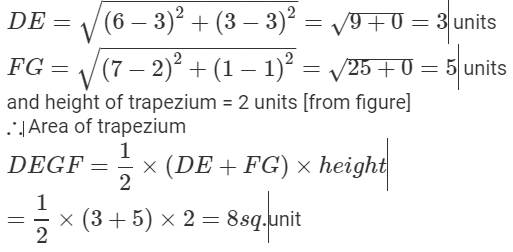

|
Explore Courses for Class 10 exam
|

|

















